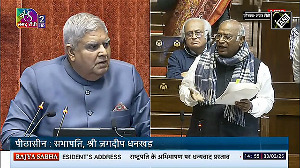 The Bangalore police have got its case right regarding the prime accused in the Bangalore BJP office blast case. However, there are several glaring discrepancies in the investigation that have the potential to derail the case in a court of law, reports Vicky Nanjappa.
The Bangalore police have got its case right regarding the prime accused in the Bangalore BJP office blast case. However, there are several glaring discrepancies in the investigation that have the potential to derail the case in a court of law, reports Vicky Nanjappa.
The chargesheet filed in the Bangalore BJP office blast case has raised several serious questions. The probe into the blast -- which the police claimed was allegedly carried out by members of Al-Ummah on April 17 in which 16 people were injured -- has certain glaring discrepancies, and if the police do not make amends it could result in a bad case before a court of law.
Looking at the contents of the chargesheet that was filed on October 20, one cannot miss to note the loopholes -- from naming of some of the accused to procurement of explosives and also relating to the funding of the attack -- in the investigation.
Discrepancy 1:
When the investigation into the case commenced, the police had named two persons as accused: Saddam Hussain and Peer Mohideen. It was said that the two were seen along with prime accused Kichan Buhari. The families of Saddam and Peer had repeatedly plead to the authorities that the two were not involved -- yet the police rubbished their versions.
However, six months on and after spending 180 days in custody, the two do not find a mention in the chargesheet.
On investigation the police found that the two had nothing to do with the blast and were only sitting with Buhari and having tea, which was wrongly construed.
Discrepancy 2:
The second discrepancy is with regard to another accused Ali Khan Kutty, whose name figures in the chargesheet. Kutty is said to be an absconding accused, but the fact is that he is very much in Coimbatore and is moving around openly, reports have revealed. The question now is how this person’s name got into the chargesheet when he has not even been questioned?
Although the police say that he is an absconding accused, there is nothing to show really that they have made an attempt to nab him.
Discrepancy 3:
The third question is with regard to the material that was sourced to be used in the blast. At first the police claimed that the Al-Ummah had sourced 30 kilograms of ammonium nitrate. The discrepancy on this point is that a seizure has not been shown and it not clear whether the police actually found this or not.
Discrepancy 4:
The final loophole is regarding the funding. The police speak about a charitable trust called the Charitable Trust for Minorities which allegedly funded the attack. It is said that the trust had given out Rs 50,000 for the blast. However, the money trail is not clear, and as per the intelligence, although the trust is under the scanner there’s nothing concrete about its operations that have come to light so far.
‘Loopholes weakening the case’
Legal experts say that such discrepancies are not good for a case.
“The police may have a strong case against the prime accused, but too many discrepancies end up taking the sheen out of the entire case which could lead in the chargesheet being trashed in court. The police should ensure that they should put into a case only what they are sure about and not speculate on the ‘ifs and buts’,” a legal expert points out.
Image: Police and forensic officials inspect the scene of a blast near the BJP office in Bangalore on April 17.
Photograph: Reuters











 © 2025
© 2025